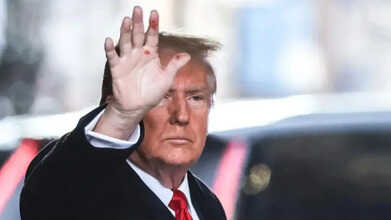- Health Conditions A-Z
- Health & Wellness
- Nutrition
- Fitness
- Health News
- Ayurveda
- Videos
- Medicine A-Z
- Parenting
Worst Wildfire In US History: Here's How Smoke Impacts People's Health

LA Fires (Credit: Canva)
Palisadas fire is wrecking havoc in Los Angeles and its vicinity. As per the latest reports, at least five people have died from the fire, several others have been injured and the famous Hollywood hills have been evacuated. While authorities are pulling all stops to control the fire, it has already spread to over 17,200 acres. Health experts, meanwhile, have warned that pollutants from these wildfires can travel miles and can affect people.
How Does Smoke From Wildfires Impact Your Lungs?
Wildfires are recurrent in US and Canada, burning more than 9.8 million acres just last year. As blazes continue to engulf LA, people are being warned about its impact on health.
Primarily, the smoke from these wildfires can be extremely harmful to the lungs, especially for children, older adults and those with asthma, COPD and bronchitis or a chronic heart disease or diabetes. Even if you don't live near wooded areas, you can learn more on how to protect yourself from wildfire smoke.
One of the many pollutants found in wildfire smoke is particle pollution, which is a mix of very tiny solid and liquid particles suspended in air. How tiny? Many of the particles in wildfire smoke are no larger than one third the diameter of your hair. These particles are so small that they enter and lodge deep in the lungs.
Particle pollution triggers asthma attacks, heart attacks and strokes—and can kill. Studies of children in California found that children who breathed the smoky air during wildfires had more coughing, wheezing, bronchitis, colds, and were more likely to have to go to the doctor or to the hospital for respiratory causes, especially from asthma.
Another threat from forest fire smoke is carbon monoxide(CO)—a colorless, odorless gas most common during the smoldering stages of a fire and in close proximity to the fire. Inhaling CO reduces oxygen delivery to the body's organs and tissues and can lead to headaches, nausea, dizziness and, in high concentrations, premature death.
US Already Battered With HMPV
The fires are ablaze in the US at the same time as it is dealing with the viral outbreak of the Human Metaneumovirus (HMPV). This virus directly attacks the respiratory system of the body. Therefore, the pollutants and toxic gasses from these fires are a double attack on one's body, and require a large and more intense immune response.In Detail: How HMPV impacts your body
After entering the body, HMPV virus attaches to the epithelial cells lining the respiratory tract, which includes airways and the lungs. These cells form a protective barrier in the airways, helping to guard the respiratory system while clearing mucus, dust, and other debris. When the body's immune system recognizes this virus, it launches a counter attack, causing inflammation and other symptoms like fever, nasal congestion and cough. In a recent statement, CDC said that it is estimated that about 10% to 12% of respiratory illnesses in children are caused by HMPV. Most people will get HMPV at some point before age 5, and then reinfections can occur throughout life.
Could Donald Trump Have Tertiary Stage Syphilis? Here’s Why This Doctor Believes It’s Possible

Credits: AP
Donald Trump’s health has long been under scrutiny, and a recent Instagram post by a physical therapist, @epistemiccrisis, who holds a doctorate and has 14 years of experience treating dementia patients, has stirred fresh speculation. The doctor discussed how tertiary stage syphilis, also known as neurosyphilis, can closely mimic the symptoms of behavioural variant frontotemporal dementia.
What Is Tertiary Stage Syphilis?
Tertiary syphilis is the late stage of a syphilis infection, and it is relatively uncommon, usually appearing years or even decades after the initial infection. Its manifestations can vary, but the most common forms include cardiovascular syphilis, central nervous system involvement—classically presenting as tabes dorsalis or general paresis—and gummatous syphilis, which most often affects the liver. In the United States, syphilis is considered a reportable illness, meaning cases must be reported to public health authorities.
Tertiary Stage Syphilis And The Brain
Tertiary stage syphilis occurs when the infection remains untreated for years, potentially causing serious neurological complications. Before antibiotics were widely available, neurosyphilis accounted for roughly 15% of psychiatric inpatients, as per the doctor. The disease can damage the frontal and temporal lobes, producing behavioural changes strikingly similar to dementia.
Case Study Explains The Symptom Overlap
The doctor referenced a PubMed case study of a 47-year-old male whose behaviour drastically changed, leading to psychiatric admission. The patient showed extreme disorientation and poor hygiene, including rubbing his own faeces in his hair. After receiving antibiotics, his symptoms resolved, and brain scans later revealed improved blood flow to the frontal lobe.
Could Donald Trump Have Tertiary Stage Syphilis?
Red marks on Trump’s hands have sparked discussion about possible tertiary stage syphilis. However, the doctor noted that untreated syphilis in someone of Trump’s age would generally produce more severe complications, making the likelihood low. Additional health factors, including possible history of stroke, heart issues, and kidney disease, further complicate speculation.
Are Frontotemporal Dementia and Tertiary Syphilis Related?
Donald Trump has been speculated to show signs of frontotemporal dementia, a condition affecting behavior, personality, and decision-making. Interestingly, tertiary stage syphilis, specifically neurosyphilis, can cause similar symptoms by damaging the frontal and temporal lobes. Both conditions may lead to changes in social behavior, judgment, and cognitive function, making it challenging to differentiate without proper medical evaluation. Unlike frontotemporal dementia, which is progressive and currently incurable, tertiary syphilis is treatable with antibiotics, underscoring the need for accurate diagnosis.
Is Tertiary Stage Syphilis Treatable?
Neurosyphilis is treatable with antibiotics, and early detection is critical. The case study highlights how the condition can mimic dementia, emphasizing the need for careful evaluation—even for high-profile figures like Donald Trump.
Disclaimer: The claims discussed in this article are being made by the Instagram user @epistemiccrisis. Health & Me does not verify or endorse these claims, and this content is intended for informational purposes only, not as a medical diagnosis or advice.
Ayush Mark Explained: What Is This New Global Standard Label For Traditional Medicine?

Credits: Canva
Prime Minister Narendra Modi unveiled the Ayush Mark at the Second WHO Global Summit on Traditional Medicine on Friday. The Ayush Mark is envisioned as a global standard for quality Ayush products and services. The WHO Global Summit on Traditional Medicine was held at Bharat Mandapam from December 17 to December 19, 2025, with this year’s theme, “Restoring balance: The science and practice of health and well-being.” Speaking at the closing ceremony, PM Modi highlighted India’s rising leadership in promoting traditional medicine as an evidence-based, integrated, and people-focused part of global health systems.
Alongside the Ayush Mark, PM Modi also introduced the My Ayush Integrated Services Portal (MAISP), the central digital platform of the Ayush Grid, released a commemorative Ashwagandha postal stamp, the WHO technical report on Yoga training, and the book “From Roots to Global Reach: 11 Years of Transformation in Ayush.” He also presented the Prime Minister’s Awards for Outstanding Contribution to the Promotion and Development of Yoga, recognizing both national and international individuals and organizations for their exceptional service.
Speaking at the event, he said, “Over the past three days, experts from across the world in traditional medicine have held meaningful discussions here. I am glad India is providing a strong platform for this, and the WHO has actively participated. It is our good fortune and a matter of pride that the WHO Global Centre for Traditional Medicine has been established in Jamnagar, India. The world entrusted us with this responsibility with great confidence at the first Traditional Medicine Summit.”
What Is The Ayush Mark?
The Ayush Mark is a label issued by the Ministry of Ayush for Ayurveda, Yoga and Naturopathy, Siddha, Unani, and Homoeopathy products and services. The Ayush Mark Certification Scheme has been run by the Quality Council of India (QCI) since 2009.
Products and services carrying the Ayush Mark follow quality manufacturing practices, use standard raw materials, and undergo safety testing. The Ayush Mark and its two previous certification levels have existed for several years. The new label builds on them and aims to set a global benchmark for traditional medicine products and services. Earlier certifications included the Ayush Standard Mark and the Ayush Premium Mark.
The Ayush Standard Mark follows Good Manufacturing Practices (GMP) for Ayurvedic, Siddha, and Unani medicines under Schedule T of the Drugs and Cosmetic Rules, 1945. The Ayush Premium Mark is aligned with WHO GMP guidelines for herbal medicines.
Dr Tedros Adhanom Ghebreyesus, WHO Director-General, also attended the WHO Global Summit on Traditional Medicine. He praised PM Modi for elevating traditional medicine to a global platform. Dr Tedros commended India for turning vision into action, calling the country a global leader in transforming traditional medicine from heritage to evidence-informed practice. He highlighted landmark initiatives like the establishment of the Ministry of Ayush and the WHO Global Centre for Traditional Medicine in Jamnagar, noting these efforts have strengthened the integration of traditional medicine into health systems, research, and policy, supporting universal health coverage and sustainable development worldwide.
Global Recognition and Impact of Ayush Mark
The Ayush Mark is not just a certification but a step toward placing Indian traditional medicine on the world stage. By setting internationally recognized quality benchmarks, it aims to boost confidence among global consumers and practitioners, encouraging the adoption of Ayurveda, Yoga, Naturopathy, Siddha, Unani, and Homoeopathy products and services worldwide. This initiative reinforces India’s role in shaping evidence-based, safe, and sustainable traditional medicine practices across borders.
What Is Denmark’s Childhood Vaccination Schedule That RFK Jr. Is Considering For The U.S.?

Credits: Canva
The Trump administration is reportedly preparing to announce changes to the childhood immunisation schedule early next year, with a proposal that would recommend fewer vaccines and bring U.S. policy closer to Denmark’s model. A source familiar with the discussions told NewsNation correspondent Libbey Dean that the revised schedule, expected next year, would involve fewer shots and would be “more in line with Denmark’s vaccination schedule,” according to The Hill. This has raised an important question: what does Denmark’s vaccine schedule look like, and is it realistic for the U.S. to follow it?
Denmark Vaccine Schedule: What Is It?
Denmark runs a clearly defined childhood vaccination programme that is free and voluntary, aimed at protecting children from serious infectious diseases. Infants are given combination vaccines that cover diphtheria, tetanus, whooping cough, polio, and Haemophilus influenzae type b, along with the pneumococcal vaccine, at 3, 5, and 12 months. Children receive their first dose of the measles, mumps, and rubella (MMR) vaccine at 15 months, with a second dose at 4 years.
A booster shot for diphtheria, tetanus, whooping cough, and polio is administered at 5 years. Around the age of 12, both boys and girls are offered the HPV vaccine to reduce the risk of cancers linked to the virus. Vaccines for chickenpox, rotavirus, hepatitis A, or meningococcal disease are not routinely included in Denmark’s standard schedule, according to official guidance from the Danish Health Authority’s Childhood Vaccination Programme.
RFK Jr. Is Considering Denmark Vaccine Schedule For US
Reports suggest that the Department of Health and Human Services (HHS) is exploring additional changes to federal childhood vaccine recommendations, with a focus on aligning them more closely with those followed by other developed nations, especially Denmark, as per The Washington Post. This discussion comes after a meeting earlier this month of the CDC’s Advisory Committee on Immunization Practices (ACIP), where childhood vaccine schedules in the U.S. and Denmark were reviewed and adjustments to the U.S. schedule were made. It was followed by a memorandum from President Trump directing HHS to begin a “process to align U.S. core childhood vaccine recommendations with best practices from peer, developed countries.”
Denmark Vaccine Schedule: What Happens If the US Adopts It?
If the U.S. were to adopt Denmark’s schedule in full, it would result in fewer vaccines being recommended for children up to age 18. When comparing vaccines that are universally advised in both countries, Denmark’s programme covers protection against 10 diseases, while the U.S. schedule includes vaccines for 16 diseases, following the removal of hepatitis B from universal recommendations. The additional vaccines recommended in the U.S. address respiratory syncytial virus (RSV), rotavirus, varicella, hepatitis A, and meningococcal disease. Although the U.S. advises more childhood vaccines than many comparable countries, Denmark stands out for recommending fewer than most. Data from the European Centre for Disease Prevention and Control (ECDC) vaccine scheduler shows that none of the other 29 ECDC member countries limits its routine childhood schedule to just 10 diseases. Several countries, including Germany, Greece, Ireland, Italy, and Poland, recommend vaccines against 15 or more diseases, while Austria’s schedule covers 17 diseases, which is even more than the U.S. currently recommends.
Every country follows its own process when setting vaccine recommendations, shaped by its specific circumstances. Childhood immunisation schedules are built over years by reviewing available evidence and weighing factors such as healthcare systems, insurance coverage, public health infrastructure, and national priorities. This explains why vaccine schedules vary across countries, and so far, no developed nation has based its decisions solely on what another “peer” country does.
Importantly, Denmark’s approach is not based on a different interpretation of vaccine science or effectiveness. Instead, Danish health authorities prioritise recommending vaccines that significantly lower the risk of death or serious illness in children. For instance, while rotavirus infections do occur among children in Denmark, they rarely result in death or long-term harm in a setting with universal healthcare access, strong medical systems, and lower inequality than in the U.S. By contrast, neighbouring countries such as Norway and Finland do include the rotavirus vaccine in their routine schedules, as does the U.S., where before the vaccine was introduced, rotavirus caused an estimated 2.7 million infections each year, leading to 55,000 to 70,000 hospitalisations and 20 to 60 deaths among children under five.
© 2024 Bennett, Coleman & Company Limited

